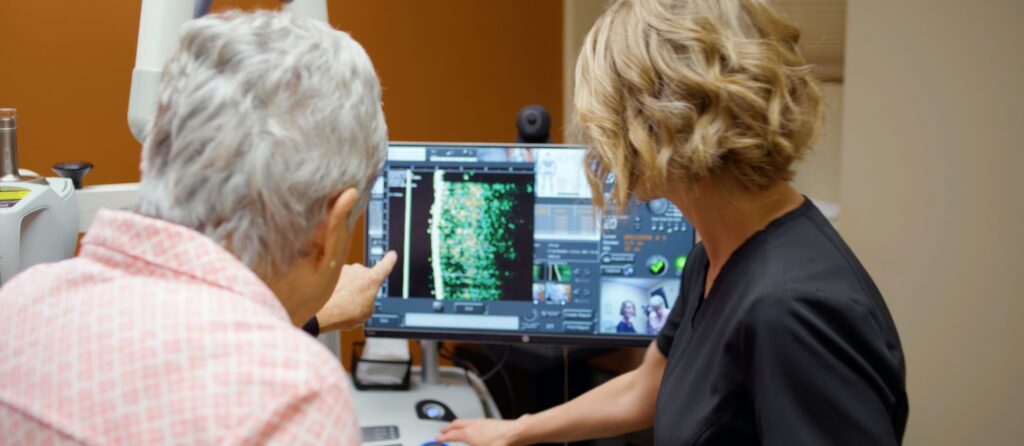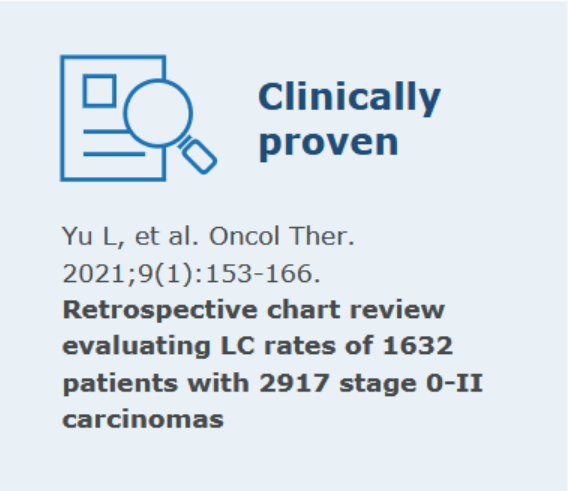SRT/GentleCure
Home > Services > GentleCure
Superficial Radiation Therapy
Unlocking the Potential of Superficial Radiation Therapy (SRT) in Dermatology
In the ever-evolving landscape of dermatology, Superficial Radiation Therapy (SRT) has emerged as a cutting-edge treatment option. This non-invasive procedure is gaining popularity for its efficacy in addressing various skin conditions. In this article, we’ll delve into the intricacies of SRT, comparing it with Mohs surgery, exploring its success rates, and shedding light on insurance coverage.
What is Superficial Radiation Therapy (SRT) in Dermatology?
Superficial Radiation Therapy, often abbreviated as SRT, is a non-surgical approach used in dermatology to treat certain skin conditions, including basal cell carcinoma and squamous cell carcinoma. Unlike traditional radiation therapy, SRT precisely targets the superficial layers of the skin, minimizing damage to surrounding healthy tissues. This makes it an appealing option for patients seeking a non-invasive and cosmetically favorable solution.
One of the notable advantages of SRT is its convenience. Typically administered in a series of brief sessions, SRT allows patients to resume their daily activities promptly. The procedure involves directing low-energy radiation beams precisely at the affected skin, destroying cancerous cells while preserving the integrity of nearby tissues.
Mohs Surgery vs. Superficial Radiation Therapy (SRT): Which is Better?
Mohs surgery, renowned for its precision in removing skin cancer layer by layer, has long been a gold standard. However, the choice between Mohs surgery and SRT depends on various factors, including the type and stage of the skin cancer, as well as the patient’s preferences.
Mohs surgery remains unparalleled in its ability to examine tissue margins immediately, ensuring the complete removal of cancerous cells. On the other hand, SRT offers a non-surgical alternative with minimal scarring and a quicker recovery period. The decision between the two often involves a collaborative discussion between the dermatologist and the patient, weighing the pros and cons based on individual circumstances.
Success Rate of Superficial Radiation Therapy (SRT):
Understanding the success rate of any medical procedure is crucial for both patients and healthcare providers. SRT has demonstrated high efficacy in treating certain skin cancers, with success rates comparable to traditional surgical methods. However, the specific success rate may vary depending on factors such as the type and stage of the skin cancer, as well as individual patient characteristics.
Several studies have reported favorable outcomes with SRT, showcasing its effectiveness in achieving complete tumor regression. The ability to tailor the treatment to each patient’s unique condition contributes to its success in achieving positive outcomes.
Is Superficial Radiation Therapy (SRT) Covered by Insurance?
Patients often inquire about the financial aspects of medical treatments, and SRT is no exception. Coverage for Superficial Radiation Therapy varies depending on the insurance provider and the specific terms of the policy. It’s essential for patients to consult with their insurance carriers to determine the extent of coverage for SRT.
Embracing Innovation in Dermatology
Superficial Radiation Therapy stands at the forefront of innovation in dermatological treatments. Its non-invasive nature, coupled with high success rates, positions it as a compelling option for individuals seeking effective solutions for skin cancer. As technology continues to advance, SRT exemplifies the evolving landscape of dermatology, offering hope and healing for patients facing skin-related challenges.
Park Avenue Dermatology is proud to offer the non-surgical, gold standard treatment for nonmelanoma skin cancer

If you suspect that you have skin cancer or have recently been diagnosed and were told you need treatment, schedule an appointment with us today. We offer GentleCure (Image-Guided SRT)—the surgery-free, gold-standard treatment for skin cancer. On your first visit, we will review your pathology report, discuss your treatment goals, and work with you to determine the treatment option that best meets your needs.
Want to cure your skin cancer without surgery?
GentleCure is a gentle, surgery-free treatment that is safe and has a 99%+ cure rate in basal and squamous cell skin cancers. Treatment is done right in the dermatology office over the course of a few weeks using an advanced Image-Guided SRT machine. It is the only skin cancer treatment with ultra-sound imaging that lets you see the cancer on the screen and review the progress made throughout the course of treatment until there are no visible signs of cancer.

See what to expect with treatment
GentleCure (Image-Guided SRT) is designed to treat skin cancer without the discomfort and cosmetic issues often associated with surgery. There is no cutting, surgical scarring, or need for reconstructive surgery, and you can maintain your normal daily activities throughout treatment.

At each treatment session, you will sit in a chair and ultrasound gel will be applied to the site of the cancer. Using an imaging wand, we will look at a detailed image of your cancer on screen. You can see the image yourself from the comfort of the chair. We will use that image to measure the size and shape of the tumor, calculate the precise dose of treatment, and define the treatment area.

Once the imaging is complete, the arm of the device will be placed over the treatment site and the exact dose of X-ray energy will be used to treat the cancer site without harming the healthy tissue around it.

Each treatment session takes about 15 minutes from the time you walk in the door to when you leave the office. You will come back several times a week for short treatment sessions, and in 4-to-7 weeks, treatment will be complete.
Watch our short video
Learn more about the treatment experience and what to expect with GentleCure (Image-Guided SRT).
See more videos about the GentleCure (Image-Guided SRT) experience. [link to: https://www.youtube.com/
@GentleCureIGSRT]
More than 66,000 patients have been successfully treated with GentleCure (Image-Guided SRT)
Patients report being satisfied with GentleCure (Image-Guided SRT). In a survey of more than 12,000 patients who completed treatment, 99.9% reported being happy with their treatment decision
and said they would recommend GentleCure
(Image-Guided SRT) to others.
Visit GentleCure.com/Patient Stories to hear from some of them. [link to: https://www.gentlecure.com/patient–stories/]
GentleCure (Image-Guided SRT) has a proven track record that is backed by science and clinical research
At Park Avenue Dermatology, our team of dermatologists reviewed the published research and here is what we found:

- In 2021, chart reviews were conducted for 1632 patients who had Image-Guided SRT to treat one or more early-stage basal or squamous cell skin cancers. Of those patients, 2917 skin cancers in total were treated. The results showed a 99.3% cure rate with Image-Guided SRT, which we believe to be equal to or better than Mohs surgery.
- In 2022 and 2023, additional studies were published that showed
the efficacy and safety of Image-Guided SRT to be superior to
non-image-guided forms of radiation therapy across skin cancer
types—confirming its use as a first-line treatment for basal and
squamous cell skin cancers. This means doctors and patients
should give equal consideration to Mohs surgery and surgery-free
Image-Guided SRT as standards of care.
More information about the published research supporting the use of GentleCure (Image-Guided SRT) can
be found here.
Why we chose to offer GentleCure (Image-Guided SRT)
There are several different radiation-based treatments available for skin cancer. But the safety, cure rates, and cosmetic outcomes vary based on the treatment technology and clinical protocols used. We chose GentleCure (Image-Guided SRT) because it is the only skin cancer treatment with advanced imaging that lets us see and measure the cancer and adapt the dose to precisely what you need at each stage of treatment. It has also been shown to be the safest and most effective of all radiation-based treatments for skin cancer with superior cosmetic results.
If you are considering radiation therapy to treat your skin cancer, make sure you are getting GentleCure (Image-Guided SRT) with adaptive radiotherapy protocols. It’s the safe, effective, and gentle way to treat skin cancer using the most advance treatment technology available today.
Treatment results – Seeing is believing!
No two cases of skin cancer are the same, so treatment results may vary from patient to patient. But the pictures below are typical of the results seen by patients who have received GentleCure (Image-Guided SRT).

BEFORE TREATMENT
Patient with basal cell skin cancer on the top of the ear before treatment with GentleCure (Image-Guided SRT). You can see the
cancer on the skin. The ultrasound image clearly defines the skin
cancer under the skin, indicating the full depth, width, and breadth
of the cancer.

DURING TREATMENT
About half way through treatment with GentleCure (Image-Guided SRT), you can see the cancer reducing in size on the outside of the
skin. The ultrasound image shows that the cancer under the skin has also been reduced.

AFTER TREATMENT
At the two-week follow-up visit after treatment was completed, the
outside of the ear shows no signs of cancer. The ultrasound image
shows that GentleCure (Image-Guided SRT) continued to eliminate
the cancer. At the 30-week follow-up appointment, the ultrasound
image showed no signs of cancer.
GentleCure (Image-Guided SRT) is covered by Medicare and most health insurance plans
With most insurance plans, you may have to pay some out-of-pocket cost. That cost will depend on your specific health plan coverage and co-pay policy. Before you commit to a treatment option, we will work with your insurance plan to determine the potential cost to you, so you can make an informed treatment decision. If you are worried about affording treatment, let us know and we can discuss our financial assistance options.
Side effects and cosmetic results
When X-ray energy is used to kill cancer cells, your body will replace the dead cancer cells with healthy tissue over time. There is no surgical scarring and no need for reconstructive surgery. There is, however, a small risk of skin atrophy (thinning of the skin) and pigment changes (changes in the color of the skin) at the treatment site. Other potential side effects may include skin inflammation with redness and swelling at the treatment site. Topical creams or ointments can be used over the course of treatment to minimize these side effects, and the side effects usually go away 2-to 6-weeks after treatment is complete. There is also a risk of alopecia (hair loss) in the treated area only.
In the 7 years that patients have been receiving GentleCure (Image-Guided SRT), there have been NO reported cases of secondary skin cancers occuring as a result of treatment.
Park Avenue Dermatology is proud to offer the non-surgical, gold-standard for the treatment of nonmelanoma skin cancer
GentleCure (Image-Guided SRT) is a safe and effective, surgery-free treatment for nonmelanoma skin cancers. It is the only skin cancer treatment that is done right in the dermatology office. GentleCure (Image-Guided SRT) is covered by most health insurance plans. Best of all, GentleCure (Image-Guided SRT) is a clinically appropriate treatment option for the majority of people diagnosed with basal cell, squamous cell, and other types of skin cancer.
When it comes to skin cancer treatment, you deserve options. We are here to help.
Appointments are available. If you have been diagnosed with skin cancer and told you need Mohs surgery, or you are concerned that you may have skin cancer and need treatment, give us a call and schedule your appointment today.

